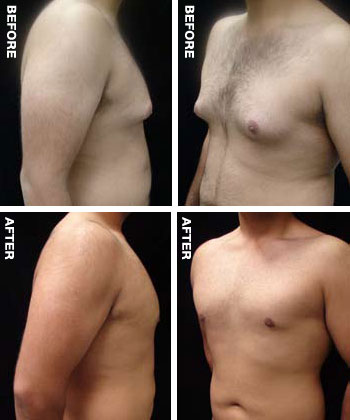
What is breast reduction for men?
Also known as gynaecomastia, breast reduction for men is the surgical correction of over-developed or enlarged breasts in men. The condition of over-developed or enlarged breasts in men is common in men of any age. It can be the result of hormonal changes, hereditary conditions, disease or the use of certain drugs.
Gynaecomastia can cause emotional discomfort and impair your self-confidence. Some men may even avoid certain physical activities and intimacy simply to hide their condition.
Gynecomastia is characterised by:
- Excess localized fat
- Excess glandular tissue development
- A combination of both excess fat and glandular tissue
- Gynaecomastia may be present unilaterally (one breast) or bilaterally (both breasts)
Male breast reduction candidates
Gynaecomastia surgery is a good option for you if:
- You are physically healthy and of relatively normal weight
- You have realistic expectations
- Your breast development has stabilised
- You are bothered by the feeling that your breasts are too large
Adolescents may benefit from surgery, although secondary procedures may be needed in the future should breast development continue.
Male breast reduction surgery is best performed on:
- Men whose condition cannot be corrected through alternative medical treatments
- Healthy individuals who do not have a life-threatening illness or medical conditions that can impair healing
- Non-smokers and non-drug users
- Men with a positive outlook and specific goals in mind for improving the physical symptoms of gynaecomastia
Breast reduction for men is a highly individualised procedure and you should do it for yourself, not to fulfil someone else’s desires or to try to fit any sort of ideal image.
What to expect during your consultation
The success and safety of your gynaecomastia procedure depends very much on your complete candidness during your consultation. You’ll be asked a number of questions about your health, desires and lifestyle.
Be prepared to discuss:
- Why you want the surgery, your expectations and desired outcome
- Medical conditions, drug allergies and medical treatments
- Use of current medications, vitamins, herbal supplements, alcohol, tobacco and drugs including steroids
- Previous surgeries
What happens during gynaecomastia correction surgery?
Plastic surgery to correct gynaecomastia is technically called reduction mammaplasty, and reduces breast size, flattening and enhancing the chest contours. In severe cases of gynaecomastia, the weight of excess breast tissue may cause the breasts to sag and stretch the areola (the dark skin surrounding the nipple). In these cases the position and size of the areola can be surgically improved and excess skin may be reduced.
Anaesthesia: Medications are administered for your comfort during the surgical procedure. The choices include intravenous sedation and general anaesthesia. Your doctor will recommend the best choice for you.
Liposculpture: In cases where gynaecomastia is primarily the result of excess fatty tissue, liposuction techniques alone may be used. This requires insertion of a cannula, a thin hollow tube, through several small incisions. The cannula is moved back and forth in a controlled motion to loosen the excess fat, which is then removed from the body by vacuum suction. There are various liposculpture techniques that may be used; including laser lipolysis – the technique most appropriate in your case will be defined prior to your procedure.
Excision: Excision techniques are recommended where glandular breast tissue or excess skin must be removed to correct gynaecomastia. Excision also is necessary if the areola will be reduced, or the nipple repositioned to a more natural male contour. Incision patterns vary depending on specific conditions and surgical preference. Sometimes gynaecomastia is treated with both liposculpture and excision.
Will there be scars? Any surgical treatment to correct gynaecomastia will require incisions. While most incision lines are concealed within natural contours, some may be visible and are a necessary result of breast reduction surgery.
Further Reading about Male Breast Reduction Surgery
- Gynecomastia Sydney – Male Breast Reduction Surgery by Dr Kernohan Plastic Surgeon NSW
- Male Breast Reduction Surgery for Gynaecomastia | My Klinik
- Gynaecomastia Surgery Sydney – Male Breast Reduction
- Male Breast Reduction Surgery Melbourne by Dr Carmen Munteanu FRACS (Plas)
- Gynaecomastia – Male Breasts – Man Boobs – Anca Breahna

